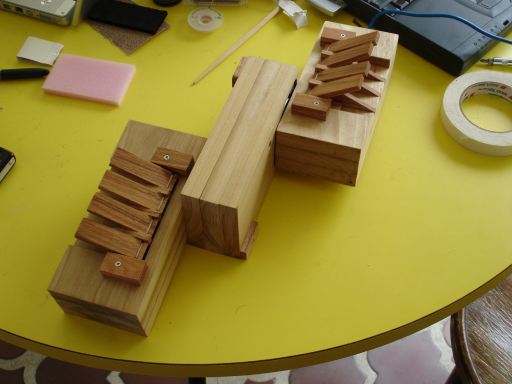el lechero is an instrument and physical computer interface, mixing the functionality of a joystick with the instrumental feel of a keyboard or accordian. Two blocks, each with 4 pressure sensitive keys, are fastend to a third center block on two joints of rotation. Holding the two outer blocks with the hands, one can play the finger keys while simultaneously unfolding el lechero on it's two rotary pivots.

Each of the eight keys as well as the two rotary joints can deliver a control signal to the computer with 10-bit resolution. To do this, special sensors and joints were contstructed. The keys are made using magnets and hall effect sensors which measure the proximity of the south pole of the magnet to the sensor. The two rotarary joints were hand crafted from tubing, flange-mounted bearings and potentiometers. The joints needed to be solid enough to withstand the tension of movement and hollow to allow internal wiring to pass through.

Despite many innovations and wierd prototypes built by academics and industry types, interaction with a computer is still mostly defined by a single keyboard (with a very specific key layout) and a mouse. There seems to be something very simple, natural, and partially magical with the immediate hand-driven action that these two devices provide and the reciprical virtual reaction inside the computer. Like many of the instruments in use for medical, mechanical or musical practices, both the keyboard and the mouse are driven by the hands. el lechero was built with two design guidelines: it should be aesthetically and functionally simple, and it should emphasize the ergonomics and "feel" of a physical instrument as it fits to the size and shape of the hands.

